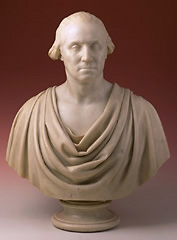Curriculum Materials: Art in America
|
|
Image 8 Hiram Powers Questions: Look Questions |
Think Questions
1. Hiram Powers carved a PORTRAIT BUST of President Washington. Why might an artist make a bust instead of a full-body sculpture? Why might someone want a smaller sculpture? This bust is about lifesize. Where would you place this sculpture if it were yours?
2. How old do you think George Washington is in this PORTRAIT? Why did Hiram Powers represent the president as an aging man? What qualities do you think Powers is trying to emphasize?
3. What does CLASSICAL mean? What does "neo" mean? What does NEOCLASSICAL mean? What aspects of this sculpture evoke ancient Greece and/or Rome? Did George Washington really wear a toga? What did he wear? Why did Powers show George Washington wearing a toga?
4. This sculpture was made in the mid-1800s. Did Hiram Powers see George Washington in person? How do you think he knew what Washington looked like? If you were going to make a PORTRAIT of a 20th-century U.S. president, what visual sources would you consult?
5. How is a chunk of marble made into a sculpture? Before carving this BUST in marble, Powers made a clay model. How is making a sculpture out of marble different from making one out of clay?
6. Compare and contrast Powers's PORTRAIT BUST and Sully's painting of George Washington. What MEDIUM does each artist use? How much of the president's body does each include? Are the representations of Washington's face alike or different? How? Which portrait appears more NATURALISTIC? How does each use SYMBOLISM? What CLASSICAL references does each include?
|
|
